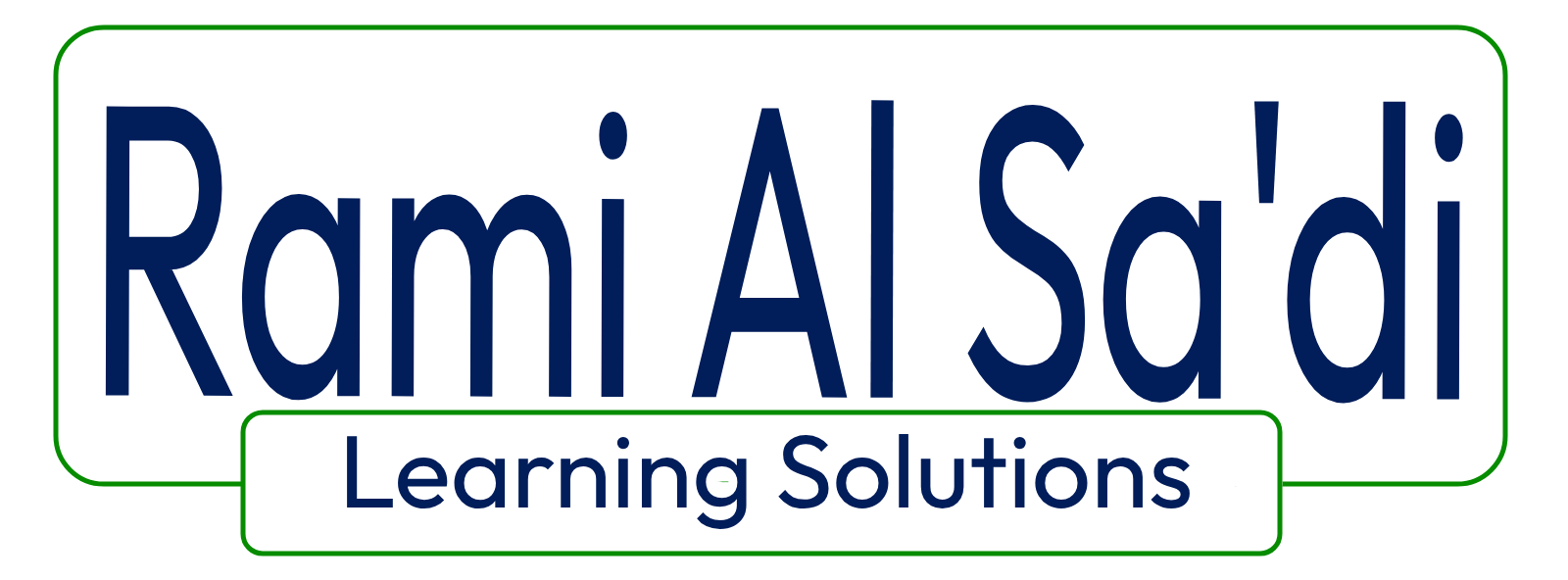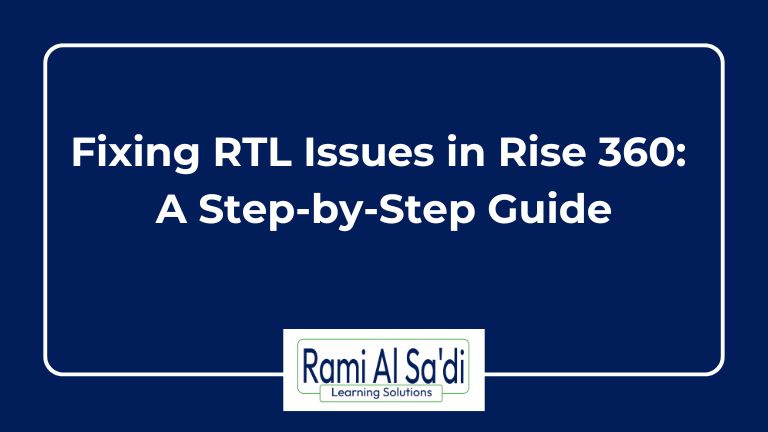Audience: Instructional designers and eLearning developers localizing English content into Arabic (and back).
Outcome: Ship accurate, readable, culturally aware Arabic versions with fewer reworks.
Most of the Localization losses come from rework.
This list significantly reduces them and speeds up the launch.
TL;DR
- Decide what to localize (UI, text, media) and what to keep as-is.
- Plan RTL early: fonts, spacing, line length, icons, numbers, and punctuation.
- QA on real devices with native Arabic readers; verify accessibility and performance.
- Keep a one‑page checklist and a small glossary/style guide.
- Track decisions to avoid repeating work in the next course.
1) Scoping: What’s actually being localized
Decide scope before you start. It saves cycles and surprises.
Content types
- UI: navigation labels, menus, buttons, tooltips, error messages, status strings.
- Text: slide copy, headings, callouts, transcripts, knowledge checks, feedback.
- Media: screenshots, images with text, videos (captions/VO), animations, infographics.
- Data formats: dates, times, numbers, units, currency.
Questions to lock early
- Which strings come from the authoring tool vs custom HTML/JS?
- Are screenshots being re‑shot in Arabic UI, or annotated with callouts?
- Will you localize voice‑over or use captions only?
- Which assets are reference‑only (keep English) vs learner‑facing (localize)?
Deliverables to prepare
- A strings sheet (CSV) with ID, English, Arabic, notes, context link.
- A screens list with “needs new capture” tags.
- A media plan: what gets captions, VO, or both.
2) Arabic UX basics that matter (RTL, fonts, line length, numerals)
RTL layout & mirroring
- Use true RTL containers; don’t fake it by right‑aligning LTR text.
- Mirror navigation order, previous/next arrows, breadcrumbs, accordions, and chevrons/icons.
- Ensure reading order and tab order follow RTL.
Fonts & readability
- Prefer robust Arabic typefaces with multiple weights (e.g., Cairo, Noto Naskh Arabic, IBM Plex Sans Arabic, Tajawal).
- Avoid ultra‑light weights; aim for comfortable x‑height and clear diacritics (if used).
- Target body text ~16–18px on desktop equivalents; check mobile scaling.
Line length & spacing
- Aim for 35–55 characters per line for body copy; increase line‑height slightly (1.5–1.7).
- Avoid full justification unless you manage kashida/hyphenation; ragged‑left often reads cleaner.
Numerals & punctuation
- Choose Arabic‑Indic (٠١٢٣٤٥٦٧٨٩) or Latin (0–9) based on audience & context; stay consistent.
- Mirror punctuation where appropriate (parentheses, arrows).
- Align lists, tables, and data columns to support RTL scanning.
Text expansion & density
- Arabic can be 15–25% longer than English; avoid cramped layouts.
- Prefer stacked information (short lines) over heavy paragraph blocks.
2a) Cultural & contextual review (names, places, currencies, imagery)
What to check
- Names & roles: Use neutral, common Arabic names (e.g., Leila, Omar). Avoid stereotypes; don’t tie errors to specific nationalities.
- Locations & maps: Prefer region‑appropriate examples; avoid disputed boundaries in maps/flags. If sensitive, use generic city/region labels or disclaimers.
- Currencies & numerals: Show local currency first (e.g., د.أ 25), optionally add a secondary currency (USD). Choose Arabic‑Indic or Latin numerals and stay consistent.
- Units & formats: Prefer metric; include conversions if needed. Standardize dates (dd/mm/yyyy or long form), time (24‑hour), and the local working week (Sun–Thu). Consider Hijri dates if relevant.
- Photos & illustrations: Avoid offensive gestures or culture‑specific hand signs; ensure modest, professional dress; represent gender diversity respectfully; avoid stereotypes in occupations.
- Scenarios & examples: Adapt holiday, meal, and time‑of‑day references (e.g., Ramadan scheduling). Avoid alcohol or culturally sensitive imagery unless context requires it.
- Legal & policy references: Verify local privacy, data residency, safety rules; avoid implying legal advice; align with org policies.
Practical guidelines
- Replace screenshots with Arabic UI when learners must replicate steps.
- Use neutral examples when geopolitical sensitivity is possible; prefer “the team”/“the branch office” over country stereotypes.
- For prices, show local currency and optionally USD in parentheses.
- Keep names short and pronounceable; avoid transliteration that looks awkward.
- Include a terminology note when using dialect or sector jargon; default to MSA for clarity.
Review workflow
- Pre‑production: Script/storyboard cultural pass by a native SME.
- Design: Visual check (icons, gestures, clothing, maps, flags).
- Final QA: Content + compliance sign‑off; log decisions in the glossary/style guide.
QA tasks (add to checklist)
- Names/roles appropriate
- Places/maps neutral
- Currency, units, dates standardized
- Images respectful/inclusive
- Scenarios/time/holidays locally realistic
- Legal/policy references vetted
3) Media workflow (captions, voice‑over, on‑screen density)
Captions
- Keep 1–2 lines, ≤ 35 characters per line where possible.
- Break at natural phrase boundaries; avoid mid‑word splits.
- Include speaker labels if multiple voices; keep timing readable.
Voice‑over
- Arabic pacing may need slightly longer timing; allow pauses for dense terms.
- Keep background music low; prioritize clarity.
- Provide a pronunciation guide for acronyms and technical terms.
On‑screen text & graphics
- Reduce text density on slides; use progressive disclosure (accordions/tabs).
- Recreate infographics with RTL layout; don’t just flip images with English text.
- Replace English screenshots with Arabic UI captures when learners must replicate steps.
4) Variables & logic (Storyline/HTML): mirroring and conditions
Language toggles
- Use a language variable (EN/AR) to switch UI, captions, and content.
- Store strings in resources (variables/JSON) to avoid hardcoding.
- Ensure persistence across slides/scenes and in suspend data.
Dynamic layout
- Bind text containers to auto‑height; avoid fixed heights that clip Arabic.
- Apply direction: rtl on AR containers; set unicode‑bidi sensibly for mixed strings.
- Mirror icons/chevrons conditionally based on language.
Data & forms
- Accept both numeral systems; format on display.
- Validate right‑to‑left input fields and cursor behavior.
5) QA plan: linguistic • functional • accessibility • devices
Linguistic QA (native reviewer)
- Terminology consistency, tone, and clarity.
- Numbers, dates, units, currencies.
- Voice‑over timing vs captions.
Functional QA (developer)
- Language toggle, navigation order, mirrored icons.
- Triggers/variables in Storyline or JS in HTML builds.
- No clipped text; no overflow on mobile.
Accessibility QA
- Contrast ratios, focus states, and keyboard navigation.
- Screen reader order in RTL; alt text in Arabic.
- Caption readability and controls.
Devices & performance
- Test mobile + low bandwidth scenarios; check font rendering.
- Browser matrix for your audience (Chrome/Edge/Safari/Firefox).
- Track load time and memory spikes.
6) Handover pack: glossary • style guide • tricky strings
- Glossary: English ⇄ Arabic terms with notes and do/don’t examples.
- Style guide: tone, numerals choice, punctuation, dates, bullets, casing for acronyms.
- Tricky strings list: hard UI labels, constraints, and any workarounds.
- Assets: fonts (with licenses), caption files, VO scripts, layered design files.
- Change log: what changed, why, and by whom.
7) Common pitfalls (and quick fixes)
- Late RTL switch: Apply RTL at the start; refactoring UI later is costly.
- Over‑dense captions: Limit line length; rephrase instead of shrinking fonts.
- Mixed numerals: Pick a system and stick to it; note exceptions (codes, URLs).
- Mirroring missed: Check arrows, progress steps, sliders, and icons.
- Clipped text: Use auto‑height containers; test on small screens.
8) Minimal “start‑today” plan
- Duplicate your EN course → create AR branch.
- Create strings sheet and glossary (seed with top 100 strings/terms).
- Switch base fonts → verify body size and line height.
- Enable RTL containers and mirror core navigation.
- Localize one pilot module (5–10 mins) end‑to‑end.
- Run Linguistic + Functional QA on mobile + desktop.
- Capture a before/after checklist and lessons learned; apply to the rest.


